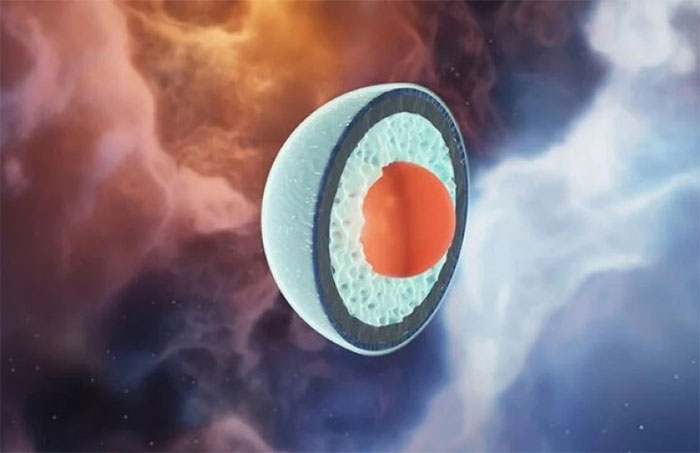Quark matter in neutron stars
Inside the neutron stars is the 'noodle nucleus' - an unusual state of matter, consisting of subatomic particles called quarks.
Physicists gather new data from analysis of gravitational waves formed during the collision of neutron stars in August 2017 (symbolized GW170817). The data show that the cores of neutron stars are so dense that the atomic nucleus ceases to exist, concentrating into quark matter. This is an important turning point in identifying extremists.
'The confirmation of the existence of the quark core in neutron stars is one of the goals of neutron star physics from about 40 years ago' - theoretical physicist Aleksi Vuorinen at Helsinski University (Finland), said.

The quark core can appear inside the neutron star.
Neutron stars are actually dead objects - including the remains of heavy stars, with masses between 8 and 30 times the mass of the Sun. When these stars turn into supernovas, most of their mass is thrown into space; and the core collapsed into dense objects. Protons and electrons in atoms are compressed into neutrons and neutrinos. Neutrino particles 'run' into space, leaving neutrons under high pressure. The neutrons bind to each other, forming a star with a dense nucleus, called a ' noodle nucleus'.
Scientists hypothesize that under temperatures and pressures high enough, neutrons also decay into quarks, creating a material called 'quark soup' . However, it is difficult to determine what is inside the neutron star. The collision of GW170817 from August 2017 is the one that caught the attention of astronomers, because the way the two stars change as they approach each other can reveal more details about the side structure. in of them.
Aleksi Vuorinen's team found that neutron stars, at least twice the mass of the Sun, show characteristics that indicate the presence of a quark core. 'There is a probability, though not great, that all neutron stars consist only of nuclear matter. However, we can assess that what kind of conditions are required for such a scenario. In short, maintaining dense nuclear material is unusual. For example, the speed of sound in such an environment must be approximately equal to the speed of light ' - Mr. Vuorinen explained.
The discovery of quark matter in neutron stars can help scientists better understand the youngest phase of the universe. Scientists believe that, within a few microseconds of the Big Bang (called the quark era) the universe was filled with a hot quark-gluon plasma 'soup'.
- The original gold smelter in the universe
- What is a Neutron Star?
- Roscosmos announces the sound of neutron stars
- Found signs of dark matter
- Finding strange stars Neutron is twice as massive as the Sun.
- Detecting unprecedented neutron stars, challenging the physical limit
- Discover the source of gravitational waves from neutron stars
- The neutron star collision is 520 million light-years from Earth
- New discovery: Collisions of neutron stars produce heavy elements of strontium
- The gravitational wave suspected by the black hole swallowed the neutron star emitted
- Video: The crazy dance of Vela neutron stars
- The thousand-star explosion shot gold, silver and platinum throughout the universe
 Van Allen's belt and evidence that the Apollo 11 mission to the Moon was myth
Van Allen's belt and evidence that the Apollo 11 mission to the Moon was myth The levels of civilization in the universe (Kardashev scale)
The levels of civilization in the universe (Kardashev scale) Today Mars, the sun and the Earth are aligned
Today Mars, the sun and the Earth are aligned The Amazon owner announced a secret plan to build a space base for thousands of people
The Amazon owner announced a secret plan to build a space base for thousands of people NASA discovers two stars colliding so violently that they created gold
NASA discovers two stars colliding so violently that they created gold  James Webb Telescope Discovers Massive Supercluster Hidden Deep in the Milky Way
James Webb Telescope Discovers Massive Supercluster Hidden Deep in the Milky Way  'Time travel' 13.5 billion years, NASA telescope finds 4 cosmic ancestors
'Time travel' 13.5 billion years, NASA telescope finds 4 cosmic ancestors  Why there are no stars in American photos of the Moon
Why there are no stars in American photos of the Moon  Aliens control the fastest moving stars in the galaxy?
Aliens control the fastest moving stars in the galaxy?  First 'hybrid' star and planet object revealed outside the Milky Way
First 'hybrid' star and planet object revealed outside the Milky Way 